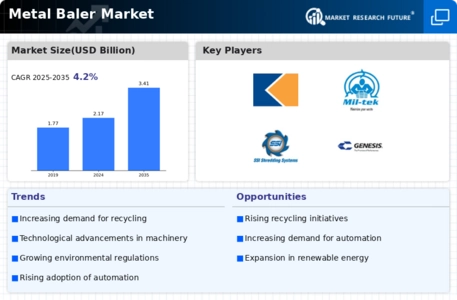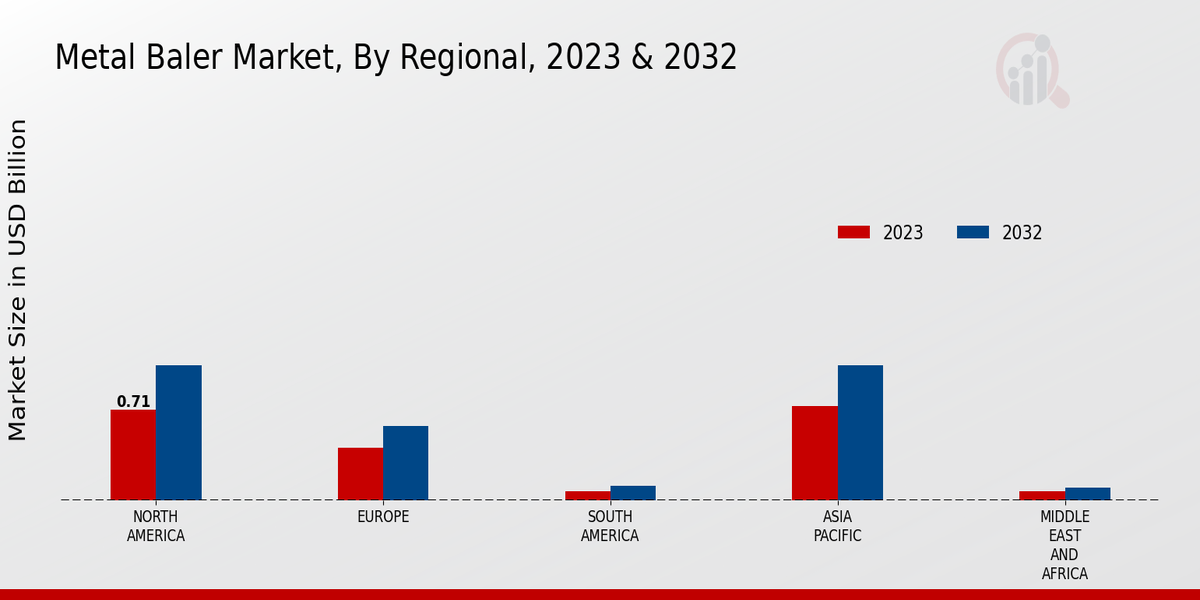Market Growth Projections
The Global Metal Baler Market Industry is projected to experience substantial growth over the coming years. With a market value anticipated to reach 2.17 USD Billion in 2024 and further expand to 3.41 USD Billion by 2035, the industry is poised for a robust trajectory. The expected CAGR of 4.19% from 2025 to 2035 reflects the increasing adoption of metal balers across various sectors. This growth is driven by factors such as rising recycling rates, technological advancements, and regulatory support for sustainable practices. The market's expansion indicates a strong alignment with global trends towards sustainability and resource efficiency.
Rising Scrap Metal Prices
The fluctuations in scrap metal prices are a crucial driver for the Global Metal Baler Market Industry. As global demand for metals rises, so do the prices of scrap metal, incentivizing businesses to invest in baling equipment to maximize their returns. Higher scrap prices encourage more efficient collection and processing of metal waste, leading to increased utilization of balers. This trend is particularly evident in regions where metal recycling is becoming more economically viable. As the market evolves, the correlation between scrap prices and baler demand is expected to strengthen, influencing overall market growth.
Technological Advancements
Technological innovations within the Global Metal Baler Market Industry are transforming operational efficiencies and product offerings. Advanced baling technologies, such as automated systems and energy-efficient designs, are becoming increasingly prevalent. These innovations not only enhance the performance of metal balers but also reduce operational costs for businesses. For example, the integration of IoT (Internet of Things) capabilities allows for real-time monitoring and maintenance, thereby minimizing downtime. As companies seek to optimize their recycling processes, the demand for technologically advanced balers is expected to grow, contributing to the market's projected CAGR of 4.19% from 2025 to 2035.
Increasing Demand for Recycling
The Global Metal Baler Market Industry experiences a notable surge in demand driven by the increasing emphasis on recycling initiatives worldwide. Governments and organizations are advocating for sustainable practices, leading to a heightened need for efficient metal recycling solutions. For instance, the global recycling rate for metals is projected to rise, with the market expected to reach 2.17 USD Billion in 2024. This growth is indicative of a broader trend towards circular economies, where metal balers play a critical role in processing scrap metal for reuse. As environmental regulations tighten, the adoption of metal balers is likely to accelerate, further propelling market expansion.
Regulatory Support for Sustainable Practices
Regulatory frameworks promoting sustainability are pivotal in shaping the Global Metal Baler Market Industry. Governments worldwide are implementing stricter regulations regarding waste management and recycling, which directly impacts the demand for metal balers. For instance, policies aimed at reducing landfill waste and encouraging recycling initiatives create a favorable environment for the adoption of balers. This regulatory support not only enhances the market's growth potential but also aligns with global sustainability goals. As industries adapt to comply with these regulations, the reliance on efficient baling solutions is likely to increase, further driving market dynamics.
Growth in Construction and Manufacturing Sectors
The Global Metal Baler Market Industry is significantly influenced by the expansion of the construction and manufacturing sectors. As these industries grow, the demand for metal products increases, subsequently driving the need for efficient metal recycling solutions. In particular, the construction sector's reliance on steel and aluminum creates a substantial volume of scrap metal, necessitating the use of balers for effective processing. This trend is expected to bolster the market, with projections indicating a rise to 3.41 USD Billion by 2035. The interplay between industrial growth and recycling capabilities underscores the importance of metal balers in supporting sustainable practices.
















Leave a Comment